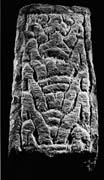Select a site alphabetically from the choices shown in the box below. Alternatively, browse sculptural examples using the Forward/Back buttons.
Chapters for this volume, along with copies of original in-text images, are available here.
Object type: Part of cross-shaft [1]
Measurements: H. 43.2 cm (17 in); W. 23.5 > 17.2 cm (9.25 > 6.75 in); D. 15.2 > 14.6 cm (6 > 5.75 in)
Stone type: Medium-grained, non-calcareous, light grey to very pale brown (10YR 7/2–7/3) sandstone; deltaic channel sandstone, Saltwick Formation, Aalenian, Middle Jurassic; from North Yorkshire Moors
Plate numbers in printed volume: 755-758
Corpus volume reference: Vol 3 p. 200
(There may be more views or larger images available for this item. Click on the thumbnail image to view.)
A (broad): A rough flat edge moulding extends along the edges and top of the face. It contains a kind of ring-chain, roughly executed. The rings are the upper half of circles in median-incised strand, arranged to overlap. Large return loops, attenuated into points lying against the moulding, lock the ring. There are three of these. At the top, the ring is extended to form two vertebral elements and the loops are clumsily scrolled.
B (narrow): The flat edge moulding is extended across the top of the panel. Within is densely packed interlace using median-incised strands: four-strand plain plait, terminating at the top in a simple pattern F element (Carrick Bend) and bar terminal. Single pellets are inserted in the central crossing points and down the left-hand edge. At that side too the strand is expanded into a wedge to meet the moulding; one of these has vertical incisions.
C (broad): Exceedingly worn. The flat edge moulding is also extended across the top of the tapering panel. Within, the design resembles face A's at the base, with the top half of a ring-knot. Above it a whole ring is visible with strands linking it to the element below. At the top there may have been a return loop locked by a transverse median-incised bar. The loose strands at the top take the form of S-shaped fillers and a small volute to an upright triangular element. The strands are broad and flat.
D (narrow): The flat edge moulding is damaged. Within the panel two adjacent runs of meander pattern 1 are awkwardly juxtaposed. At the top the strand is fused into an inner plain transverse moulding.
This is a clumsy piece but an oddity. There is no parallel for the ring-chain made up of the upper halves of ring-knots. The two vertebral elements are more typical of ring-chain but their stems are uppermost in the Cumbrian manner (cf. Gosforth 1, Cumberland (Bailey and Cramp 1988, 100–4, ills. 297–8)), which is strange for this area. Meander pattern is also rare in the Ryedale area, though more common to the north of the Moors. Most surprising is the expanded wedge that meets the moulding on face B. This is a way of correcting badly accommodated interlace, but it is a feature on Odd's cross at Braddan in the Isle of Man (Fig. 7j) (Lang 1978c, 16, fig. 3E).
The resolution of the pattern at the top of face C may be related to Levisham 3.



